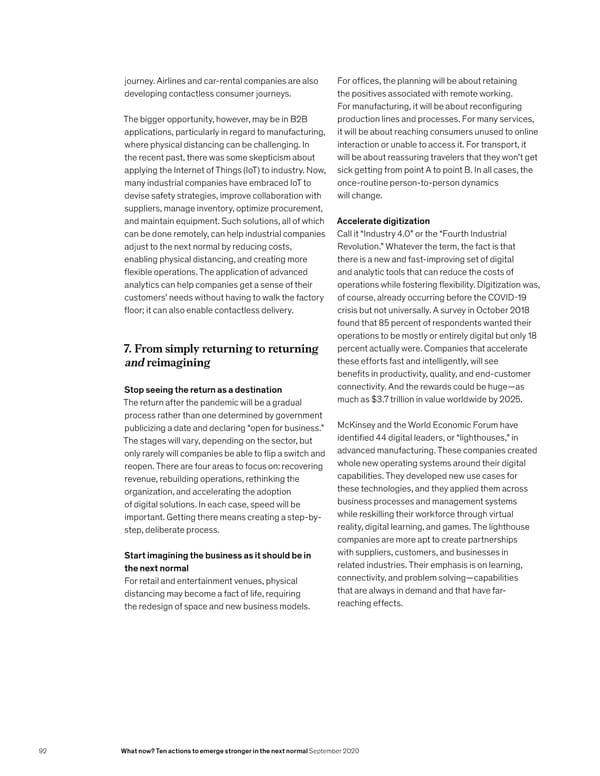journey. Airlines and car-rental companies are also For offices, the planning will be about retaining developing contactless consumer journeys. the positives associated with remote working. For manufacturing, it will be about reconfiguring The bigger opportunity, however, may be in B2B production lines and processes. For many services, applications, particularly in regard to manufacturing, it will be about reaching consumers unused to online where physical distancing can be challenging. In interaction or unable to access it. For transport, it the recent past, there was some skepticism about will be about reassuring travelers that they won’t get applying the Internet of Things (IoT) to industry. Now, sick getting from point A to point B. In all cases, the many industrial companies have embraced IoT to once-routine person-to-person dynamics devise safety strategies, improve collaboration with will change. suppliers, manage inventory, optimize procurement, and maintain equipment. Such solutions, all of which Accelerate digitization can be done remotely, can help industrial companies Call it “Industry 4.0” or the “Fourth Industrial adjust to the next normal by reducing costs, Revolution.” Whatever the term, the fact is that enabling physical distancing, and creating more there is a new and fast-improving set of digital flexible operations. The application of advanced and analytic tools that can reduce the costs of analytics can help companies get a sense of their operations while fostering flexibility. Digitization was, customers’ needs without having to walk the factory of course, already occurring before the COVID-19 floor; it can also enable contactless delivery. crisis but not universally. A survey in October 2018 found that 85 percent of respondents wanted their operations to be mostly or entirely digital but only 18 7. From simply returning to returning percent actually were. Companies that accelerate and reimagining these efforts fast and intelligently, will see benefits in productivity, quality, and end-customer Stop seeing the return as a destination connectivity. And the rewards could be huge—as The return after the pandemic will be a gradual much as $3.7 trillion in value worldwide by 2025. process rather than one determined by government publicizing a date and declaring “open for business.” McKinsey and the World Economic Forum have The stages will vary, depending on the sector, but identified 44 digital leaders, or “lighthouses,” in only rarely will companies be able to flip a switch and advanced manufacturing. These companies created reopen. There are four areas to focus on: recovering whole new operating systems around their digital revenue, rebuilding operations, rethinking the capabilities. They developed new use cases for organization, and accelerating the adoption these technologies, and they applied them across of digital solutions. In each case, speed will be business processes and management systems important. Getting there means creating a step-by- while reskilling their workforce through virtual step, deliberate process. reality, digital learning, and games. The lighthouse companies are more apt to create partnerships Start imagining the business as it should be in with suppliers, customers, and businesses in the next normal related industries. Their emphasis is on learning, For retail and entertainment venues, physical connectivity, and problem solving—capabilities distancing may become a fact of life, requiring that are always in demand and that have far- the redesign of space and new business models. reaching effects. 92 What now? Ten actions to emerge stronger in the next normal September 2020
 What Now? Page 93 Page 95
What Now? Page 93 Page 95